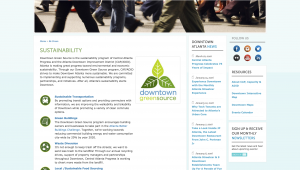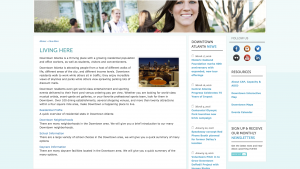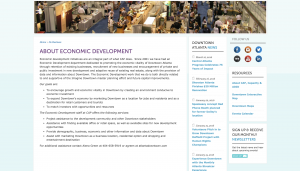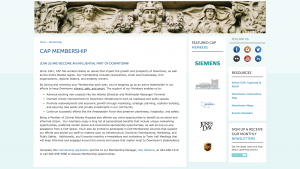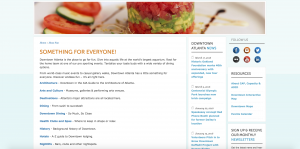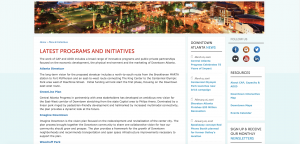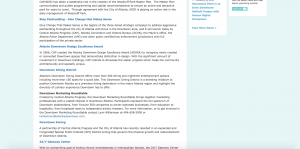 The official homepage for Central Atlanta Progress and Atlanta Downtown Improvement District (CAP/ADID) can be found with the link: www.atlantadowntown.com. Working side by side, CAP and ADID are committed to creating a thriving Downtown Atlanta community for all of its property owners, employees, residents, students and visitors. The work of CAP and ADID includes a broad range of innovative programs and public-private partnerships focused on the economic development, the physical environment and the marketing of Downtown Atlanta.
The official homepage for Central Atlanta Progress and Atlanta Downtown Improvement District (CAP/ADID) can be found with the link: www.atlantadowntown.com. Working side by side, CAP and ADID are committed to creating a thriving Downtown Atlanta community for all of its property owners, employees, residents, students and visitors. The work of CAP and ADID includes a broad range of innovative programs and public-private partnerships focused on the economic development, the physical environment and the marketing of Downtown Atlanta.
Upon visiting the site, visitors can see that the homepage is pretty straightforward with it organization, where each section is categorized into its own box laid out across the webpage. The first thing that draws the visitors attention would be the circulating pictures with links to further information, positioned at the center frame of the website. The pictures that are in repeat circulation shows images of vibrant popular Downtown Atlanta locations with its people and the organizations that reside within its city. Next to this are links to their social media networks and information about CAP/ADID and what the organization does. The CAP/ADID’s homepage also provides a quick overview of information about news, upcoming events, and a blog relating to Downtown Atlanta. For more in-depth information on events coming to Downtown Atlanta visitors can click on the link Events, same thing goes for Downtown Atlanta News and Blog.
The website is notably simplistic and easy when it comes to navigation. On the top of the homepage are six colorful tabs clearly labeled categorizing the central information of the website. Each tab drops down, when visitors hover their mouse over them which further breaks down that tabs category into further topics. Plus the tabs are always on the top of the website, so that the visitors can access them on whatever webpage they are on. The first tab on the website is Plans & Initiatives, this page lists all the current innovative programs that the CAP/ADID are working on. Visitors can click on the title of the programs to be linked to more information on how the program is helping Downtown Atlanta’s development. The second tab is Have Fun, this page showcases all the recreational attractions around Downtown Atlanta in a categorize list of links. The links are organized in categories such as, architecture, dining, hotels, parks, shopping, sports, and walking tours. Each link directs to a webpage that gives places relating to that topic and even pins it on a map for you. This page was clearly aimed at tourist looking for a fun places to visit in Downtown Atlanta. The third and fourth tabs are Live Here and Do Business. The Live Here tab gives reasons on why visitors of this site should live in Downtown Atlanta, giving links to residential profiles, Downtown neighborhoods, school and daycare info. The Do Business tab explains the goals of CAP/ADID in terms of economic development within Downtown Atlanta. The fifth tab is Be Green, this page describes the sustainability program of CAP/ADID named Downtowns Green Source. This webpage is committed to showing the implementations and support the CAP/ADID are doing to promote a sustainable Downtown Atlanta. Links are listed to provide more information on sustainable transportation, waste diversion, water conservation and green spaces. The last tab is Membership, this page tries to convince visitors to join and become a member of Central Atlanta Progress (CAP). This webpage gives reason on why some should become a member and how; also it showcases all the organizations that are current members on the side of the webpage.
The Central Atlanta Progress and Atlanta Downtown Improvement District (CAP/ADID) is a website that tries exhibit how life is in Downtown Atlanta and the organization that keeps it thriving. Although the website design itself is kind of bland and monotoned, it makes up for it with its vibrant colorful pictures of Downtown Atlanta location and people with accurate and insightful information about the city locations and the organization that keeps it running smoothly.
